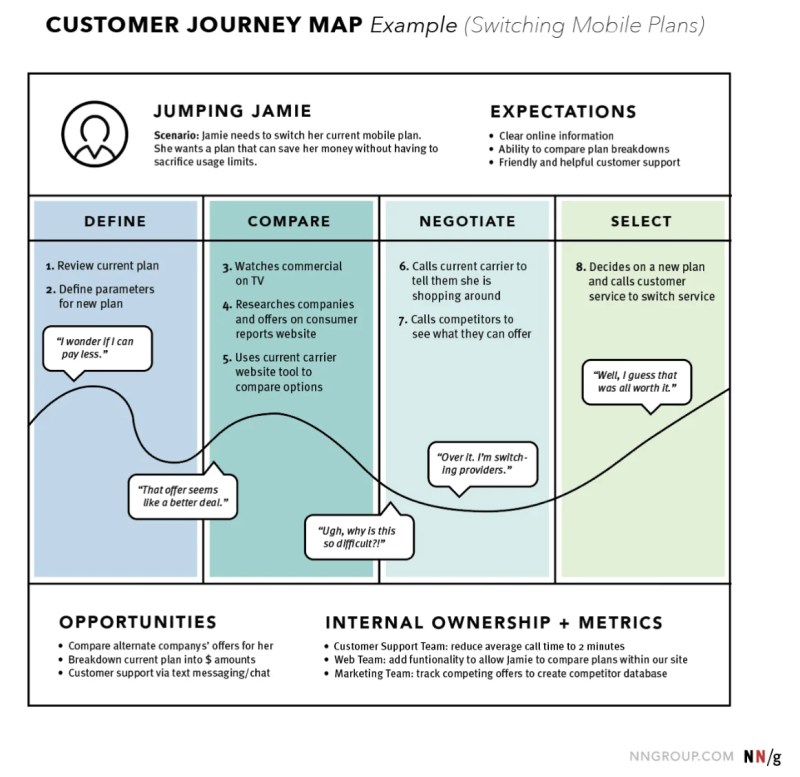Key Takeaways
🔦 Understanding the customer journey is critical for enhancing the overall user experience.
🔍 Customer journey management provides businesses with a comprehensive view of the customer experience.
💡 A customer journey is the set of interactions that the customer experiences with a particular product service or brand.
Competition in the digital marketplace is fierce, and consumers’ growing expectations make customer journey management essential. Fortune Business Insights projects the global customer journey analytics market to grow from $4.53 billion in 2024 to $10.08 billion by 2032.
This growth indicates a significant investment in technologies that enhance understanding of customer behaviors across various touchpoints.
In this article, we are going to explore customer journey management, implementation strategies, and tools to improve customer experiences.
What is a customer journey?

A customer journey is the set of interactions that the customer has with a particular product service or brand.
From the first moment that the customer becomes aware of the existence of a product or a service through to the initial consideration about purchasing it as well as the purchase and post-purchase interactions, all these interactions make up the customer journey.
However, the customer journey is not always linear – as consumers often jump between interactions or use multiple channels and devices to complete a transaction.
Last but not least, it is important to note that the feelings and emotions that arise as a consumer goes through this journey shape the consumer’s perception of this particular brand.
As Peter Haid, CX Strategist at Lumen Technologies, says:
Customer journey management is the discipline of understanding, planning, implementing, and optimizing a portfolio of journey maps to generate value-building enhancements to the customer experience.
Stages of the customer journey
To effectively optimize the customer journey it is critical to gain an understanding of its various stages. Here are the key stages a customer will typically go through:
Awareness
The first stage of every customer journey is the awareness stage where a customer first finds out about a brand. The awareness stage usually occurs through advertising or word-of-mouth.
The main objective of this stage is to not only inform the potential customers about the benefits of your product or service but also to generate some interest in it. Personalized and targeted advertising can really do the trick here!
Consideration
Consideration is the second stage of any customer journey and is the stage where the customer considers their options. Typically the consumer here will conduct some sort of research to compare prices and find the best available solution offered on the market.
Providing detailed product descriptions and real customer testimonials can be a real game changer in this stage!
Purchase
The purchase stage is the stage where the customer decides to buy the product or complete a transaction. A user-friendly and reliable checkout process is of utmost importance here as it can truly affect your conversion rate.
Retention
Once the transaction is completed, the customer passes to the retention state. This stage is all about nurturing the relationship that you have with the customer in an effort to make them purchase again!
Loyalty programs and personalized follow-up emails with recommendations but most importantly a user-friendly website can really foster retention. Google found that 74% of people will revisit your website if it’s user-friendly, meanwhile, 50% of customers will stop visiting it if it’s not.
Advocacy
In the advocacy stage, happy customers become champions of the brand spreading the word by writing reviews or recommending the brand to their friends and family. Brands can nail this stage by providing a seamless user experience throughout the whole customer journey.
What is customer journey management?
Customer journey management is all about understanding and continuously optimizing the interactions that a customer has with a brand. The user journey map management involves analyzing user behavior and improving every touchpoint based on data.
The importance of customer journey management

Nailing your customer journey management plan is crucial for a ton of reasons. Here are the key ones:
Comprehensive view of the customer experience
Customer journey management provides businesses with a comprehensive view of the digital customer experience.
Mapping out the customer journey and its key touchpoint can really help organizations visualize how customers interact with the brand and identify gaps as well as areas for improvement.
Higher customer lifetime value
Effective customer journey management can contribute to higher customer lifetime value. Satisfied customers are more likely to come back for more leading to sustainable revenue.
Anticipation of friction points before they arise
Effectively managing your brand’s customer journey offers businesses a unique opportunity to proactively identify friction points and areas for improvement. In this way, organizations can address those issues early on and avoid the risk of customer dissatisfaction.
Improved personalization
Last but not least, effective customer journey management allows organizations to deliver tailor-made experiences by leveraging customer insights. In turn, personalization can foster a strong bond between the customer and the brand.
Customer journey management framework

Establishing a structured framework can really help you hit the ground running when it comes to effective customer journey management. The customer journey management framework typically consists of the following steps:
Customer journey mapping
Start by taking note of all the interactions the customers have and identify the key touchpoints as well as any emotions that might arise from those. This will help you make informed decisions about enhancements. Study examples of the user journey map to conceptualize the process.

Source: NN/group
Collection of customer insights
Next up is gathering customer insights and data to better understand the needs, expectations, and preferences of your customers. Then simply use these to inform your customer journey management strategies.
Journey touchpoints optimization
Once you have a better understanding of the key touchpoints in the user journey, it is time to start optimizing them ensuring that interactions are smooth and seamless.
Iterative feedback collection
Optimization is an iterative process and so is feedback collection. Establishing regular feedback loops can help you remain relevant in an ever-changing demanding market.
Cross-functional collaboration
Last but not least, cross-functional collaboration between departments such as marketing, product, and customer support is key when it comes to effective customer journey management.
Implementing a customer journey management system

If you are unsure how to implement an effective customer journey management system, here are the main steps to follow:
1. Define KPIs
Start by identifying your key performance indicators to be able to measure the success of your customer journey management system. Retention rates, conversion rates, and NPS scores are some of the key metrics that you can use for this purpose.
2. Map the customer journey
Mapping the customer journey and creating a detailed visualization of every customer touchpoint is another critical step for an effective journey management system.
Your customer journey map should always be actionable. It’s not just a pretty picture you hang on your wall and call it done. It’s a springboard and catalyst to robust projects and definable action.
3. Integrate essential tools
Integrating essential tools such as analytics and customer experience research platforms or CRM systems is another key step when it comes to successfully managing your brand’s customer journey.
4. Gather and analyze customer data
Gathering and analyzing customer data and user insights is quintessential for an effective customer journey management system. Those insights should inform decision-making and be the driver for product improvements and touchpoint optimization.
5. Optimize touchpoints
Continuously optimize every touchpoint throughout the customer journey by making the necessary refinements. Regularly reviewing how each touchpoint performs can help you stay ahead of the curve when it comes to customer needs and expectations.
6. Establish an iterative feedback loop
Creating and establishing regular feedback loops can also massively help to proactively manage your customer journey and stay reactive when it comes to customer needs.
7. Train teams
Training key teams especially those that have direct interaction with customers is also critical when it comes to effective customer journey management. From tried-and-tested customer service techniques to acquiring stellar product knowledge there is always something to master!
8. Establish reporting procedures
Finally don’t forget to establish reporting procedures to help you stay on track when managing your customer journey.
Tips for optimizing the customer journey touchpoints

Here are some of our top tips when it comes to optimizing the customer journey touchpoints for your brand:
Use predictive analytics & A/B testing
With predictive analytics, organizations have a unique opportunity to predict user behavior based on historical data and make informed decisions about how to optimize key touchpoints. On the other hand, A/B testing can also help organizations experiment with different strategies or content to engage customers.
See how you can do it yourself with UXtweak! 🍯
Design micro-interactions
Carefully designing micro-interactions can also massively help organizations optimize their customer journey touchpoints. Elements such as animations or user feedback mechanisms can really make or break your key touchpoints and how those are perceived by customers.
Use dynamic content & gamification
Using dynamic content offers organizations a unique opportunity to tailor their message and content based on the preferences of the customers maximizing the chances of grabbing their attention!
On the other hand, adopting gamification tactics such as offering rewards can also motivate the consumer to engage with your brand.
Integrate AI customer support
Last but not least, riding the AI wave and integrating AI customer support, such as AI-power bots and virtual assistants, can help you significantly enhance the customer experience when it comes to real-time support.

Here are some key customer journey management tools that can help you effectively manage your customer journey:
CRM tools
Customer relationship management tools can help you keep track of your customers and the stage of the customer journey they are in. These tools are great as they can massively help not only with data collection and analysis but also with managing and building strong customer relationships.
Customer journey mapping tools
Experience mapping tools can help you create a helpful visualization of your customer journey streamlining the mapping process.
Journey orchestration tools
Journey orchestration tools allow businesses to manage customer interactions that occur across multiple channels and different devices always assuring a similar experience.
Voice of customer (VoC) tools
Voice of customer tools can help you gather customer feedback and insights that then can be used for data-backed-up decision-making.
User research tools
Finally, user research tools, such as UXtweak, can help you effortlessly collect both qualitative and quantitative data. Those can significantly aid in better understanding the needs and expectations of your customers.
If you’re searching for a tool to better understand your customers, we recommend UXtweak. 🐝
Current trends in customer journey management

Here are the current hot trends in customer journey management:
Predictive customer intent mapping
Predictive customer intent mapping is all about leveraging predictive analytics for proactive decision-making, and trend identification resulting in tailored experiences that exceed customer expectations.
Personalization with emphasis on privacy
Another hot trend in customer journey management is personalization but with a huge focus on privacy. With consumers becoming more and more knowledgeable and conscious of their privacy, organizations must step up and consider more ethical data practices.
Emotion-driven journey designs
Emotional design is here to stay and so are emotion-driven journey designs. Creating touchpoints that resonate with your consumers on a deeper level can make or break your brand’s customer journey.
In an nutshell
Understanding your brand’s customer journey and actively seeking to enhance the key touchpoint should be at the top of your list if you are running a digital business.
By proactively optimizing their customer journey organizations have a unique opportunity to create strong and long-lasting relationships with customers benefiting from sustainable growth and revenue.
If you want to better understand how your customers think and behave, UXtweak is the right tool for you. Book a demo to lean more about it or go ahead and try it yourself! ⬇️


